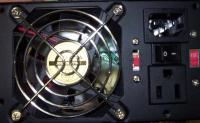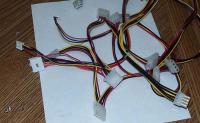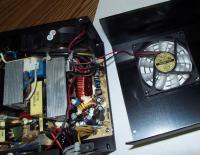4-Way Power Supply Shootout: Vantec, Enermax, ThermalTake, Antec
by Kristopher Kubicki on January 17, 2003 4:31 AM EST- Posted in
- Cases/Cooling/PSUs
Vantec Stealth Aluminum
Right away we saw a lot of things we liked about the Vantec Stealth PS. The jet black paint job on the dull aluminum provides a fairly unique first impression. Obviously, as cases have begun to switch to aluminum chassis, the next evolutionary step is to also construct the power supply out of aluminum. The theoretical advantage to using aluminum in housing design is to disperse the heat as much as possible in a system. Aluminum has a fairly good ability to transfer heat, and thus distributing it along a large surface area. Naturally, the more surface area to dissipate heat, the more effective an air cooling solution. Unfortunately, aluminum technology really hasn’t shown the advantages people would like to see in cases.
The second noticeable advantage the Stealth possesses comes in the form of three heat sensing fans. Typically, we see OEM power supplies with one or two fans. Unfortunately, as PC’s demand more and more on power supplies, the maximum wattage and current has been on the rise. Before the AMD Athlon debuted with a 300W PS requirement, most systems required a mere 200 watts to power all the necessary components. Now with the power hungry Pentium 4’s and higher speed Athlons, typical OEM power supplies are rated over 400W. Aside from the 420W supply we are testing today, Vantec also has a 470W and a 520W Stealth, each with a peak load of 570W and 620W respectively.
|
|
|
|
Form Factor |
ATX Tower |
|
Rating |
420Watts |
|
Onboard Fans |
3 80mm Temperature Controlled Dual Ball Bearing |
|
Other Features |
Aluminum construction |
|
Provisions |
9 full size molex |
|
Connection |
Universal |
A unique feature to see was the extra power outlet provision on the rear of the unit. Once upon a time, power supplies used to come with an additional outlet in the back with the intention of using it to plug a monitor into. Unfortunately with the newer power hungry monitors and computers, the power supply was reduced to the role of providing power to only the computer. Now that Vantec, Thermaltake and Zalman have discovered the need for stable and efficient power supplies, the idea of an additional outlet has been given a new life. In addition, when the computer is off, power to the additional outlet is off as well. This is a great feature for monitors, and we expect several other power supplies on the market to also come standard with additional outlets.
Interestingly enough, the power supply comes with a 24 Pin Universal Connector. While 24-Pin DC is used mostly in high end server motherboards, it also comes with a 24 to 20 pin adaptor. Furthermore, the cable is enveloped in a nylon sheath to keep it from tangling all over the case. Unfortunately, with twelve connections for devices, a slight tangling problem would be an understatement. After we had our Stealth 420W plugged in, we ended up using several twist ties to keep all the extra connectors at bay.
The downside to the awesome features packed into the Vantec Stealth is the price and noise. With the Aluminum Stealth priced around 110USD for the 420W version, expect to save up a little before you go shopping for this PSU. The 3 onboard fans also pack quite the audible punch. We will get more into the noise level of this power supply later in the review.














6 Comments
View All Comments
Sir Fredrick - Tuesday, January 11, 2005 - link
I would have really liked to see them compare the current draw from the wall, to see how the PSUs compare in terms of energy efficiency.Anonymous User - Friday, August 22, 2003 - link
Switching power supply means the unit can be switched between American 60 Hz, 120 v, and European 50 Hz, 240 v input.Jeff7 - Monday, June 18, 2012 - link
"Switching power supply" refers to precisely what the article says. The "switch" refers to the manner in which the incoming power is handled, not to a physical component on the unit.Plenty of switching power supplies, also called SMPS (switch-mode power supplies), are available without any switches.
Beside me is a switcher supply that accepts 100-240VAC and puts out 12VDC. There are no switches on it.
Some of the circuitry I work with uses small switcher supplies, which take 12-36VDC and put out a solid 12VDC output.
I also work with boosters, which are a kind of switching power supply topology that's capable of putting out a higher voltage than what comes in. These particular ones can take 12VDC and put out about 17.5VDC.
And, I'm looking at a power supply for integration into a new product, and it can handle anything from 85-264VAC at 47-440Hz. Again, no switches on it.
Some of the older or cheaper switcher supplies *do* indeed have the selector switch on them to let them accommodate different voltages. But that's not what makes them "switching" power supplies. The name "switch" being the same is simply a coincidence.
Anonymous User - Friday, August 8, 2003 - link
:):):):):):):):)Anonymous User - Thursday, August 7, 2003 - link
Anonymous User - Thursday, August 7, 2003 - link
PFC, power factor correction, is not just about noise. The square wave shape of current draw of non PFC corrected supplies adds a significant 3rd order harmonics element to the line. This usally is gets diverted by the impedance of power company transformers to flowing in the Neutral line of the power system, which in the past carried almost no current. This nuetral line was installed at a SMALLER size than the mains. There have been buildings burned up in Europe, (which has an older infrastructure) because of this. Also, drawing higher peaks instead of sinusoidal current is less efficient and adds more loss the the wires and transformers, shortening their life and adding more pollution to the world, (ie. more power has to be generated to make up the loss, resulting in more smokestack emissions).